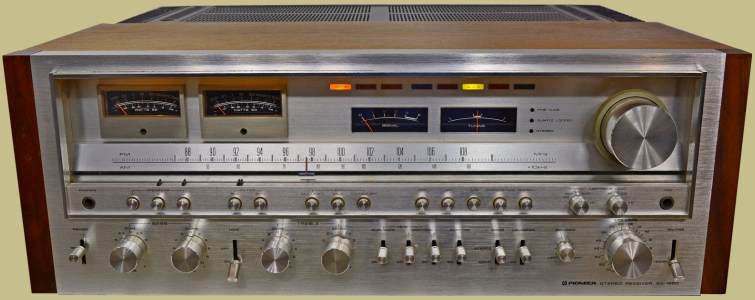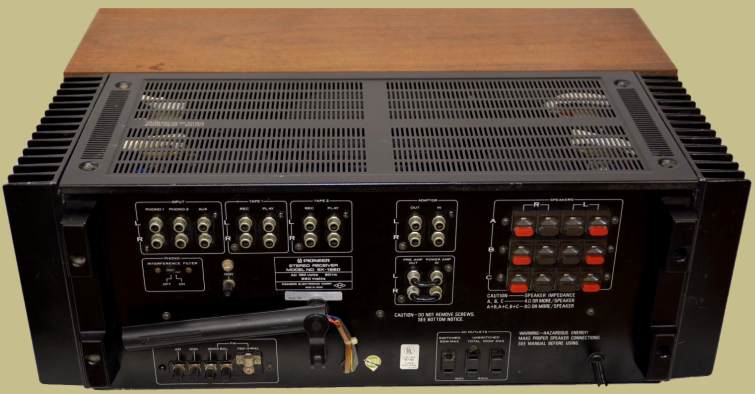As a monthly feature of this blog, Audiogon looks at some of the technological marvels of the past that may have preceded your birth, escaped your memory, or come and gone without ever having made an impression. This month, we take a look at the Pioneer SX-1980.

In the late ‘70s, with the majority of consumers having embraced transistors over tubes, the major audio manufacturers of the day had something of a good old-fashioned sword-swinging contest to see whose receiver was bigger. The people wanted more power, and by god, they would get more power. Thus the Receiver Wars were born.
And that is how we ended up with this behemoth: The Pioneer SX-1980, unleashed upon the public in 1978, weighing in at 78 pounds with a whopping 270 watts per channel into 8 ohms. Boom.

Others challenged it, both in weight and wattage — Technics’ flagship SA-1000 was actually heavier (90 lbs.), more powerful (330 WPC) AND earlier to the market (1977) — but it was the Pioneer SX-1980 that largely captured hi-fi enthusiasts’ imagination, and which still commands the greatest collectibility today among those late-’70s solid-state receivers.
The SX-1980 continues to be prized for its total harmonic distortion rating of 0.03% at rated power, which is extremely low for a receiver generating so much power and significantly less than the 1-10% common in today’s receivers. Because of this, the SX-1980 consistently ranks highly in blind testing against modern amps.
The SX-1980’s amp, according to thevintagehifishack.com, “consisted of a cascade connected, current mirror loaded, differential amplifier with a three-stage Darlington triple parallel-push-pull direct coupled OCL circuit … [w]ith a dual power supply arrangement incorporating a massive toroidal-core transformer with two independent windings and four ‘Coke Can Sized’ 22,000uf filter capacitors provid(ing) the amplifier with an enormous reservoir of power to draw from.”

Writer’s note: About a third of that preceding paragraph is Greek to me, which is why I lifted it verbatim. What I do know is that transformer weighs 22 pounds by itself, that’s some insane heatsink action going on in there, and that if this beast came with one of those yellow FTC EnergyGuide tags, the Estimated Yearly Energy Cost would just read “OH HELL NO!”
Other features of the SX-1980 included dual bass and treble tone controls to allow for finite tuning, three cartridge impedance and capacitance settings for phono input, two tape inputs/outputs to allow for tape duplication (because this was 1978, and who had a dual cassette deck?) and a unique quartz lock on AM/FM station frequency.
Among its other noteworthy specs:
- Frequency response: 5Hz to 80kHz (line)
- Damping factor: 40
- Input sensitivity: 7.5mV (mic), 2.5mV (MM), 150mV (line)
- Signal to noise ratio: 87dB (phono), 100dB (line)
- Output: 150mV (line), 2V (Pre out)
- Semiconductors: 12 x FET, 11 x IC, 130 x transistors, 84 x diodes
- Dimensions: 22” x 8 5/16” x 19 9/16”

The SX-1980 also enjoyed something the other high-wattage receivers did not — some well-timed mythos. Leonard Feldman of Audio Magazine did a spec test on the receiver for the September 1978 issue and gave the SX-1980 a big boost with this still-widely circulated claim, the stuff of which legends are made:
“Though the new [IHF mandated] “Dynamic Headroom” measurement is specified in dB, it should be mentioned that based upon the short-term signal used to measure the 2.3 dB headroom of this amplifier, it was producing nearly 460 watts of short-term power under these test conditions!”
The SX-1980 retailed for $1,295 upon release in 1978. That works out to about $5,000 in 2020 money. And $5,000 is what you might find yourself paying to purchase one today in tip-top condition, if not more (although if you keep a sharp eye out, you might score one for half that, like one Audiogon buyer earlier this year). Good luck!
Pics lifted from classicreceivers.com. You can find out more about the Receiver Wars era both there and at the aforementioned thevintagehifishack.com if you want to go down the rabbit hole for a few hours.
